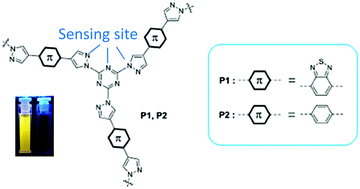Fluorescent sensing for amines with a low detection limit based on conjugated porous polymers†
Abstract
New sensors for amines with low detection limits are very crucial since pollution due to an ultralow concentration of organic amine compounds can also be harmful to human health. In order to avoid amine contamination and further reduce the detection limit of sensors, it is necessary to keep searching for new materials with better luminous performance and lower detection limit. We previously reported two conjugated porous polymers (CPPs) P1 and P2, that were constructed by pyrazole–benzothiadiazole–pyrazole and pyrazole–benzene–pyrazole light-absorbing units linked with triazine units with promising photocatalytic hydrogen evolution behavior. Considering the large conjugated systems and good luminous properties of the conjugated porous polymers (CPPs) P1 and P2, we continue to study their application in amine sensing. Both P1 and P2 can sense aromatic amines with “turn off” behavior at low detection limits of 171 nM and 81 nM, respectively. Furthermore, P1 can only be selectively sensitive to aromatic amines and not aliphatic amines, while P2 can not only sense aromatic amines, but can also sense aliphatic amines with “turn on” behavior at a low detection limit of 43 nM. Meanwhile, we found that monomers M1 and M2 are also capable of sensing, but the detection limits are not as good as P1 and P2, highlighting the importance of conjugated systems and porous properties of polymers in sensing amines.



 Please wait while we load your content...
Please wait while we load your content...